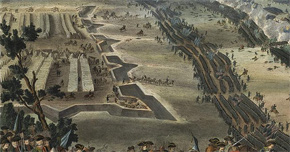|

The first fortified camp of the Russian army was built on June 20, 1709, at the site
where the Russian Army crossed the Vorskla River near the villages Semyonovka
and Petrovka. When the Russians realized that the Swedes did not intend to attack
a fortified camp, Tsar Peter I ordered his army to move and to encamp close to
the village Yakovtsy. This second camp was built during the night of June 25th.
It was rectangular in shape but open at the rear, overlooking the
Vorskla River.
The fortified camp was protected by a trench, a palisade and a rampart.
The Russians deployed approx. 25,000 infantry men and 73 guns in the camp. A small detachment of
Kozaks was posted in the Yakovetski Wood to guard the southern approaches to the camp.
In front of the camp there was a large field of sandy soil stretching
westwards. To cover the open approach to the camp and disrupt the battle formation of the
advancing Swedish army Tsar Peter I ordered two lines of square or
rectangular redoubts to be built. These redoubts were placed in the form of the letter T,
with one battalion and two guns in each redoubt.
In 1854 the cadets of the
Poltava Military School, working under the supervision of Lieutenant-General E. Wrangel, reconstructed some of the
earthworks of the camp. Unfortunately any questions concerning the exact position of the camp
were raised only in 1909, just before the 200-year anniversary celebration of the battle, when almost all
traces of the camp had disappeared. A memorial stone designed by architect P. Gumich
was installed in 1973 on the place assumed to have been the Russian command post.
|
 History
History
 Dates and events
Dates and events
 Persons
Persons
 Poltava
Poltava
 Sights
Sights
 Photo gallery
Photo gallery
 Maps
Maps
 Virtual Museum
Virtual Museum
 Armament
Armament
 Uniforms
Uniforms
 Coins and medals
Coins and medals
 Flags
Flags
 Paintings
Paintings
 Poltava photographs
Poltava photographs
 News
News
 About us
About us
 Acknowledgments
Acknowledgments
 Main page
Main page
 Photo gallery
Photo gallery
 top
top ...back
...back 